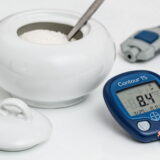Gycemic control in T2D means the management of blood sugar levels to prevent complications and maintain overall health. Better glycemic control helps to reduce the risk of complications and improve quality of life. There are various ways used to control glycemic in patients with type 2 diabetes, including medication, lifestyle changes, and regular monitoring. Examples of lifestyle modifications that help to control glycemic include a balanced diet such as focus on grains, vegetables, and healthy fats. Other lifestyle modifications include regular physical activity to help patients with T2D improve insulin sensitivity and lower blood sugar levels. The required standard of exercise is at least 150 minutes of moderate aerobic activity per week. Achieving and maintaining a healthy weight can significantly improve blood sugar control.

There are both oral and injectable medications for glycemic control among T2D patients. Oral Medications include DPP-4 inhibitors, metformin, and sulfonylureas. The injectable medications such as GLP-1 receptor agonists and insulin are prescribed when oral medications are ineffective. A combination of medications and therapies may also be used to chieve optimal glycemic control and practical tips among themselves.
Besides, regular visits to healthcare facilities can help improve glycemic control through the adjustment of treatment plans. T2D treatment should be tailored to meet each person’s needs and considering factors such as age, comorbid conditions, duration of diabetes, and risk of hypoglycemia. Furthermore, Diabetes Self-Management Education (DSME) can also help to provide patients with the knowledge and skills needed to manage their diabetes effectively. Additionally, A1C testing helps to measures average blood sugar levels over the past 2-3 months. It targets adults with a diabetes A1C score of less than seven percent. Support groups help to connect people with type 2 diabetes facing similar challenges so that they can provide emotional support.
